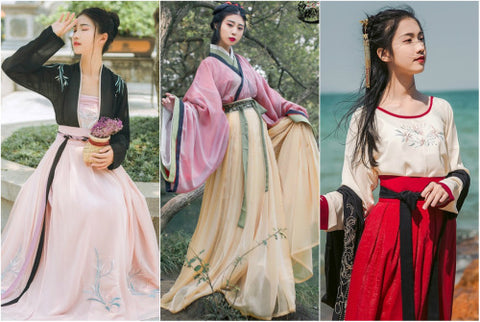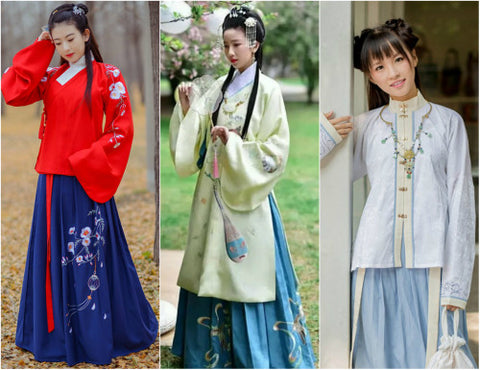- Ruqun/襦裙 - the most basic type of hanfu consisting of a top and a wrap-around skirt. The top is called “ru/襦” and the skirt is called “qun/ 裙”, hence “ruqun”. Sleeves can be narrow or wide. Generally speaking, people divide ruqun into two types based on the height of the skirt: “Qiyao Ruqun/ 齐腰襦裙” (waist-high ruqun) and “Qixiong Ruqun/ 齐胸襦裙” (chest-high ruqun).
“Qiyao Ruqun” is the kind of ruqun in which the waistband is on the waist. Both men and women can wear it. For women, the top’s collar can be parallel (left), crossed (middle), or u-shaped (right). Men’s ruqun are cross-collared only.
“Qixiong Ruqun”, on the other hand, has its waistband above the chest. The top’s collar can be parallel (left) or crossed (right). It’s only worn by women.
As seen in the photos above, ruqun is often accessorized with a long scarf called Pibo/披帛. Originally used to protect against wind and cold air, pibo gradually became an important feature of hanfu.
- Aoqun/袄裙 - a type of ruqun that became fashionable during the Ming Dynasty. It consists of a double-layered top called “ao/袄“ and a waist-high skirt (”qun”), hence “aoqun”. Unlike the “standard” ruqun that has the top tucked inside the skirt, the aoqun’s top is worn untucked, above the skirt. There are two types of “ao” - “short ao” and “long ao”. The “short ao” (left, right) reaches the waist, while the “long ao” (middle) covers the knees. Ao collars can be crossed (left, middle), upright (right), or square (not shown). Only worn by women.
- Unlike ruqun and aoqun which are made of separate top and bottom pieces, the Shenyi/深衣 style of hanfu consists of one-piece robes that wrap around the body once or several times. Quju/曲裾 (curved-hem robe) and Zhiju/直裾(straight-hem robe) are two types of shenyi. The quju (left, middle) is a robe in which the bottom hem of the left lapel spirals its way up to the waist of the wearer. Modern quju can come in a shortened version (middle) that reveals the skirt worn underneath. In contrast to the quju, the bottom hem of the zhiju (right) circles around levelly, creating a straight line. Quju and Zhiju are worn by both men and women.
- Beizi/褙子 - a parallel-collar “jacket” with side slits beginning at the armpit or at the waist. It can be secured at the front either with ties or a metal button. Extremely versatile, it can be long or short, have narrow or wide sleeves, and is worn by both men and women. During the Song Dynasty, it was popular to wear narrow-sleeved beizi over a chest undergarment and skirt/pants (middle). Another name for Ming Dynasty-style beizi is Pifeng/披风 (right). Pifeng collars can also be upright (not shown).
- Banbi/半臂 - a half-sleeve jacket worn by both men and women. It comes in various lengths and is usually worn over ruqun. Its collar can be parallel (left), crossed (middle), or u-shaped (right). When paired with ruqun, it can be worn tucked inside the skirt as well as over the skirt (untucked).
- Bijia/比甲 - a sleeveless jacket, usually worn over aoqun, that comes in various lengths and styles.
- Daxiushan/大袖衫 - large-sleeve robe commonly paired with ruqun. As its name indicates, its main feature is its broad sleeves. The length is at least 78 inches, and the width exceeds 40 inches. The material is generally thin and light, because it was originally created for wear in the summer.

